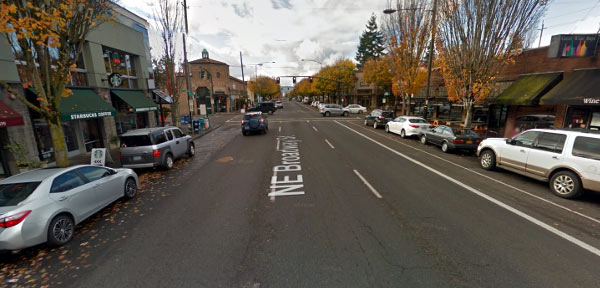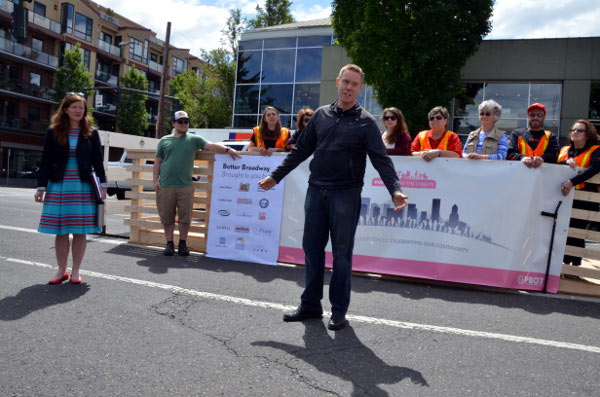(Editor’s Note: This is a case study from Portland, Oregon. For one week this month, several groups in that city transformed a one-way speedway using tactical urbanism to test out design changes to make the street safer and better for business. This is an example of one tool Louisville could use to help design better streets for people and business here at home. Here’s how the Portland project went.)
Portland, Oregon, is full of thriving retail corridors: 23rd Avenue, Alberta Street, Belmont Street, and more. But nearly all of them have something in common: no more than two travel lanes.
Auto traffic on those streets moves slowly—and those streets are frequently packed with people walking, talking and shopping.
Inner Northeast Broadway isn’t like that. At least, it hasn’t been since July 10, 1960, when the city converted the street to three one-way travel lanes west of 24th Avenue. The extra passing lanes were intended to funnel traffic off the newly completed freeway into the city center. They did, transforming the former streetcar corridor and letting cars zoom through the longtime business district.

But a freeway-style Broadway hasn’t turned out to be great for business in the 21st century, some business owners say.
“We would really love to see the city address the pedestrian safety in our corridor, where it is three lanes of traffic that are pretty much going faster than the speed limit,” said Janet Takayama, general manager of Furever Pets at 1902 NE Broadway. “It’s hard for cars coming from the side streets to turn onto Broadway, even.”
So for a full week this month, a coalition of businesses and residents is testing what it might look like to change the street again. Two community groups, the Broadway-Weidler Alliance and Northeast Broadway Business Association, teamed up with Better Block PDX for a one-week test that redesigned nearly a mile of the street with marked crosswalks, a handbuilt floating bus stop and extra sidewalk space for cafe seating. On the block with the bus stop, the design included a parking-protected bike lane.
https://www.instagram.com/p/BFN45TqJnka/
The crosswalks were sponsored by AARP Oregon. A Chinese restaurant, a taco bar and a credit union bought sponsorships for temporary bike parking racks. Volunteers were still working through the week to tweak the designs, which were reviewed and approved by the city transportation bureau. City engineers, meanwhile, installed traffic-count tubes and travel-time detectors to collect data on the test.
Mike Chronister, vice president of the Northeast Broadway Business Association and manager of the Kitchen Kaboodle store at 1520 NE Broadway, said he welcomed the chance to see in real life what was possible on the street.

“It’s exciting to see a change,” he said. “It’s really hard to visualize when someone is showing you a piece of paper.”
Chronister said that though it wouldn’t be good for Broadway to become “a parking lot,” he’d rather have slower-moving cars if that made the crosswalks more welcoming. It might also get more people to consider stopping their cars to patronize businesses instead of just cruising past.
“I think slowing down traffic is a good thing, because it gets people to see more,” Chronister said.
[Editor’s Note: This article has been cross-published from PeopleForBikes’s Green Lane Project blog. It originally appeared as part of that group’s National Protected Bike Lane Week. Follow along with PeopleForBikes on Facebook and Twitter. Top image courtesy Green Lane Project.]



A solution in search of a problem?
I agree that NE Broadway is not as charming as NE 23rd or Hawhtorne St., or Albert St. However, none of those streets feed the Convention Center, the MODA Arena, I-5 and a major cross-river bridge. We moved from San Francisco 14 years ago and I have come to think of the Broadway / Weidler couplet as the Geary Blvd. of Portland. Not so beautiful but practical.
I am 65 years old and legally blind and I don’t have problems crossing 3 lanes of traffic on NE Broadwway at NE 15th or 16h. Compared to places like Salt Lake City (which is criss-crossed with 6 and 8 lane major arteries) Portland is like a toy city (which is why I live here and not in Salt Lake City or L.A.).
Two of the Broadway businesses I frequent said that they lost business during the experiment, although customer might have mistaken the test for road construction.
I am glad Broadway has a bike lane, and having a nice home town center would be nice, but perhaps 1 or 2 more stop lights between NE 24th and NE 16th would be enough to slow down traffic.
Just saying …
Oh, one more comment, I have found that speeding cyclists who ignore traffic signals present more danger to me than drivers who mostly follow the rules of the road. A cyclist can seemingly come from no where, swerve around you and leave you feeling vulnerable and terrified.